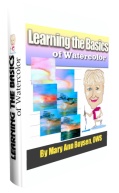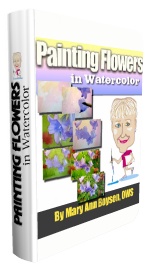Brasserie Isle St. Louis, Paris
Painting on this surface with transparent watercolor is indeed a challenge. One must select a subject that he is comfortable with.
I am challenging my self at this point to do an architectural scene from Paris, though I know that fruits and vegetables and shiny objects are much easier to paint on this surface.
I begin with a simple sketchy drawing, for I know that it is almost impossible to do great detailed work. Then, as sloppy as it may look, I paint the pale color of the building with the pink reflected light from the bright red awnings. This may look a bit dark to you, but when I establish the darks (the surrounding trees, the shade under the awnings, etc.) you will see that it isn’t dark at all. The wash isn’t smooth as it would be on watercolor paper or Rtistx or watercolor canvas, as it wants to pool up because there is absolutely no absorption. This is not important in this painting because the uneven look will disappear as I add detail work.

This phenomenon of seeing pale color against a white surface, and thinking that the wash is much too dark, happens on any surface. I once painted a white Iris on blue Bockingford paper. When I asked my students what color the flower was, they said “white”….Well, yes, in reality it was white, but because the Iris was surrounded by dark green foliage, and its crevices shaded with blue and pink shadows. …the blue paper, then appeared to be white.
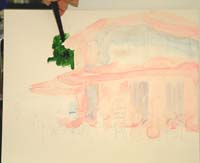
With the tip of my brush I follow the lines of the building, painting the dark green foliage which will make the building stand out….and if you notice, the building doesn’t look so dark anymore. (Tip: When painting crisp edges, always use the point of your brush, as this is the only part of the brush over which you have total control. The other end of the bristles near the ferrule will leave rough edges. You can do all sorts of contortions in order to have the brush point to the crisp edge….even turn the painting upside down, if you must. Notice that I don’t draw a line around the building, but drag color from the edge of the building in to the mass of foliage). (Illustration of foliage against building)
The beauty of the smooth Claybord® at this point is that I can lift highlight in the foliage easily. When I have completed the dark foliage, I dip the point of my brush into water and lift out the lights. You can get as detailed as you wish. I just want to have masses of light rather than every leaf on the tree. There are several ways to lift highlights. One is with a wet brush, and another to sprinkle water on the surface with a spritzer and blot with a tissue.
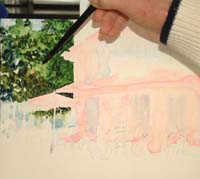
In order put emphasis in the foreground, I will have to darken the shadows on the upper part of the building, paint the awnings red, and darken the building under the awnings. It is difficult to do pale washes on the smooth Claybord®. I actually added a touch of Permanent White Gouache to the pigment to give it more body. Still the water would pool when I lifted the brush from the surface. Very frustrating. But it is the nature of the beast. It just requires patience.
In order to get details, on any surface, your brush must come to a VERY FINE POINT!
So always make sure that your Round brushes are not worn and ragged. Water is your enemy when doing fine detail, as it can suddenly be released from the bristles and cause a blob on your paper, so dip the tip in the pigment and begin to paint. You can see the beginning of the detail in the cornice on the left side of the building.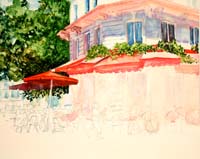
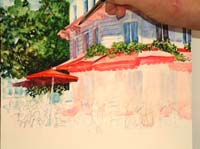
The next steps were the shadows and large dark masses in the painting. Actually it is easier to paint dry brush on this smooth Claybord®, because water and pigment float around on the surface uncontrollably. So as I approached the detail work, I used less water (if any at all!) and a fine brush to add punch to the figures. For the writing on the menu board, I used Permanent White Gouache and a fine pointed round brush. It was easier than trying to paint around the letters as I would normally do. This painting is on 8” x 10” so detail was tiny.
 The Brasserie Isle St. Louis, Paris
The Brasserie Isle St. Louis, Paris
This surface allows for a very loose painting style. My usual approach is more controlled, so it feels very strange to have the paint roll around! However, I love the look, the freshness of color (as none is absorbed), and the ability to lift highlights if needed, very easily. I have tried several paintings on this surface, and sometimes I really love it....and others, I find a bit too much of a challenge. I think, for me, certain subject matters work better on this than others. What about you? Have you tried it?


